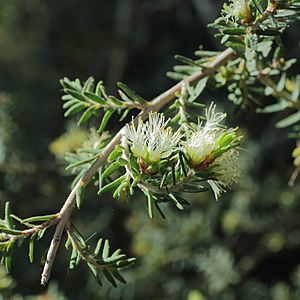Melaleuca cuticularis facts for kids
Quick facts for kids Saltwater paperbark |
|
|---|---|
 |
|
| M. cuticularis foliage and flowers in the Stockholm Botanic Garden, Sweden. | |
| Scientific classification | |
| Genus: |
Melaleuca
|
| Species: |
cuticularis
|
The Melaleuca cuticularis, often called the saltwater paperbark, is a special tree. It belongs to the myrtle family, called Myrtaceae. This tree naturally grows in the south-west part of Western Australia. You can also find a separate group of these trees on Kangaroo Island in South Australia. What makes this tree stand out are its unique fruits and its very white, papery bark.
Contents
What the Saltwater Paperbark Looks Like
The saltwater paperbark is usually a shrub. It grows to be about 1 to 7 meters (3 to 23 feet) tall. Sometimes, it can even become a tree, reaching up to 12 meters (39 feet) high.
Its leaves are long and thin. They are grey-green to dark green in color. Each leaf is about 4 to 12 millimeters (0.16 to 0.47 inches) long and 1.5 to 3 millimeters (0.06 to 0.12 inches) wide.
The trunk of this tree has pale, papery bark. This bark often peels off in strips. The branches are stiff and twisty.
Flowers and Fruits
The flowers of the saltwater paperbark grow in groups of three. They are white or cream colored. You can find them at the ends of the branches. Small, brown, overlapping leaf-like parts called bracts surround the flowers.
This tree flowers between September and January. After the flowers, woody fruits appear. These fruits are like small boxes, called capsules. When you look at them from the end, they look like stars. The fruits usually grow alone and are about 6 to 11 millimeters (0.24 to 0.43 inches) long.
How it Got its Name
A scientist named Jacques Labillardière first officially described this plant in 1806. He found a sample of it during an expedition in 1791. He wrote about it in his book, Novae Hollandiae Plantarum Specimen.
The second part of its scientific name, cuticularis, comes from a Latin word, cuticula. This word means "about the cuticle" or "skin-like". This name refers to the many strips of bark that peel off the tree's trunk and branches, looking like skin.
Where the Saltwater Paperbark Grows
The saltwater paperbark can grow in wet, salty places. These include swamps and estuaries, which are areas where rivers meet the sea.
It is common along the coast south of Perth in Western Australia. It stretches all the way to Israelite Bay. You can find it in several natural areas, including the Avon Wheatbelt, Esperance Plains, Jarrah Forest, Swan Coastal Plain, and Warren regions. It also grows, though less commonly, on Kangaroo Island in South Australia.
Protecting the Saltwater Paperbark
The good news is that the saltwater paperbark is not considered to be in danger. The Government of Western Australia's Department of Parks and Wildlife lists it as "not threatened." This means there are enough of these trees in the wild.
How People Use This Plant
This tree is great for sandy clay, loamy clay, and clay soils. People often use it to help stabilize soil and replant areas. This means it helps stop soil from washing away.
It can also handle shade and dry conditions, so it's good for hedges or windbreaks. Hedges are like living fences, and windbreaks help block strong winds. Its attractive bark and light green leaves make it a nice plant to feature in a garden.
Images for kids
-
M. cuticularis growing near Ravensthorpe




